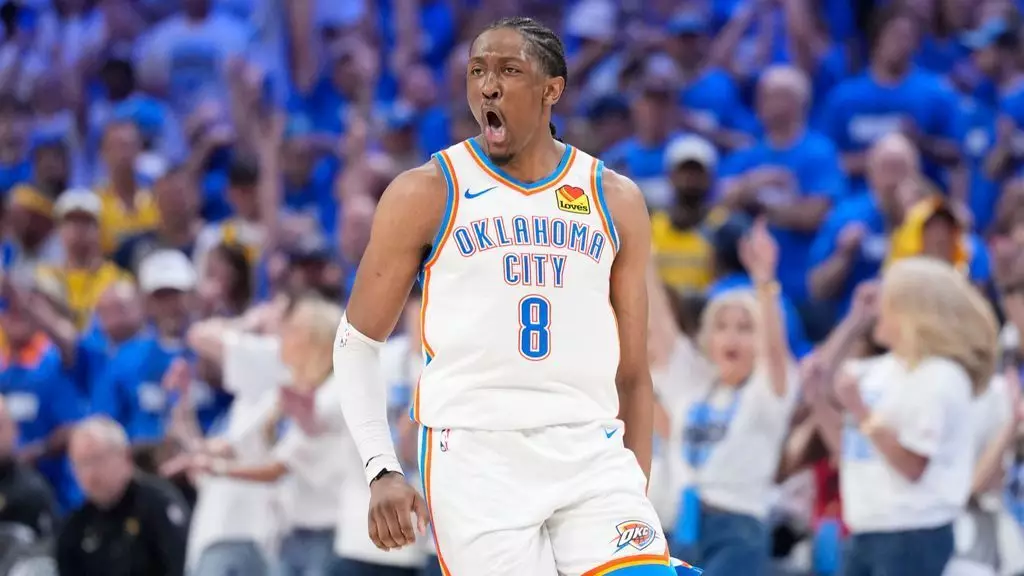Oklahoma City Thunder’s recent multi-million dollar contract extensions symbolize their unwavering belief in a promising young core. However, beneath this surface of strategic long-term investment lies a complex reality filled with both undeniable potential and troubling pitfalls. While the team’s ambition to build a championship-worthy squad has been apparent, the aggressive financial commitments raise serious questions about sustainability, risk, and whether these flashy acquisitions truly align with a cohesive, winning philosophy.
The centerpiece of the Thunder’s renewed faith in youth is Jalen Williams, a player who rose remarkably in his third season, earning All-NBA honors while battling a severe wrist injury that could have shattered his season—yet he played through it, displaying admirable resilience. Still, such resilience should not be mistaken for a reliable foundation. As Williams inked a five-year maximum rookie deal close to $287 million, one must ask: is tying such a hefty sum to a player with injury concerns and limited playoff experience a wise strategy? The gamble seems rooted more in hope than proven consistency, exposing a fundamental vulnerability in the team’s blueprint.
The team’s star-studded trio—Gilgeous-Alexander, Holmgren, and Williams—collectively command over $822 million in contracts, a staggering investiture for a franchise still navigating its identity. These long-term deals, while securing youth and talent, risk locking Oklahoma City into a financial straitjacket. The looming luxury tax penalties can cripple their flexibility, especially as they navigate the complex landscape of the NBA’s salary cap through the next decade. It’s optimistic to believe that player development alone will justify such investments, especially when injuries like Williams’ threaten to derail this carefully curated vision.
Are the Thunder Betting on Hope or Reality?
The myth of the modern NBA is that building through high-priced young stars guarantees rings. Oklahoma City has made bold strides in this direction, but history consistently warns us that youthful talent—no matter how promising—often falls short of immediate greatness. Their recent title singularity is celebrated, yes, but it was achieved by a team that had faced adversity, not merely by accumulating high-priced assets. Overextending financially in pursuit of an elusive future perpetuates a false hope, risking the destabilization of their roster.
Williams’ story is emblematic of this peril. His heroics in the playoffs, especially his dominant Finals run—culminating in consecutive scoring increases—are inspiring. Yet, it is a dangerous misconception to equate playoff heroism with franchise stability. The reality is that his injury history, combined with the team’s aggressive cap strategy, might culminate in a precarious situation where talent erodes under financial strain, or worse, injuries niggle the core that the team is so heavily banking on.
The Thunder’s approach seems rooted in the perception that holding onto multiple young stars will inevitably blossom into a championship. But what if these assets, despite the potential, do not mature simultaneously or reach the heights expected? Over-investing in a trio of promising players creates an illusion of stability—a fragile foundation that can crumble if any star suffers setbacks. The underlying question persists: does this aggressive pursuit of a “super team” not threaten to sacrifice long-term flexibility for a fleeting shot at immediate glory?
Is the Future as Bright as They Believe?
While the team’s financial commitments may seem excessive, the real debate centers on whether Oklahoma City’s ambitions are grounded in pragmatic strategy or misguided bravado. The NBA’s landscape has shifted from building slowly to chasing shortcuts via super-max deals, but at what cost? The risk of developing a roster too top-heavy to sustain over multiple seasons is real. And the danger lies less in talent and more in the failure to account for unforeseeable setbacks, like injuries or mismatched chemistry.
The Thunder’s future hinges on whether they can turn high hopes into tangible results. Their window of opportunity isn’t limitless, especially under the stress of their current salary commitments and the constraints of the luxury tax. There is a glaring need for balance—an understanding that aggressive spending is only one half of the equation; building chemistry, maintaining depth, and ensuring player health are the other critical factors.
In essence, Oklahoma City’s aggressive gamble on a young core with enormous financial backing is commendable but fraught with peril. They are betting their future on the promise of youth and talent, but neglecting the vital importance of fiscal prudence and roster stability could prove disastrous. As the league moves forward, the Thunder’s boldness might either serve as a blueprint for youthful excellence or become a cautionary tale of overreach rooted in wishful thinking rather than strategic foresight.



Leave a Reply